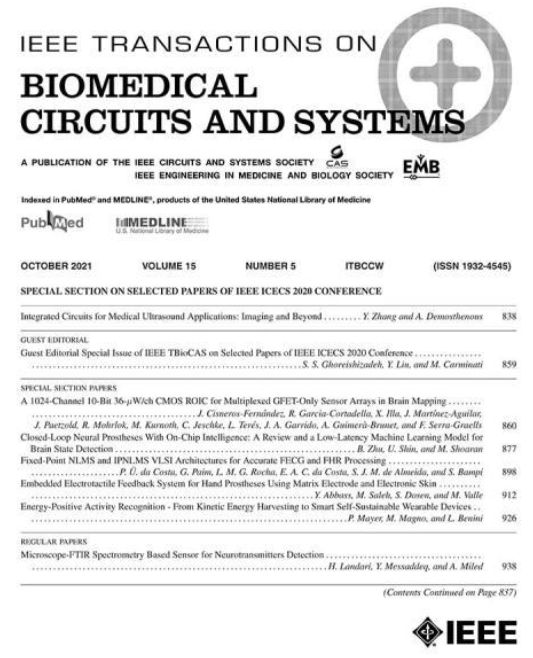Design of a Closed-Loop, Bidirectional Brain Machine Interface System With Energy Efficient Neural Feature Extraction and PID Control
IF 4.9
2区 医学
Q2 ENGINEERING, BIOMEDICAL
IEEE Transactions on Biomedical Circuits and Systems
Pub Date : 2017-08-01
DOI:10.1109/TBCAS.2016.2622738
引用次数: 92
Abstract
This paper presents a bidirectional brain machine interface (BMI) microsystem designed for closed-loop neuroscience research, especially experiments in freely behaving animals. The system-on-chip (SoC) consists of 16-channel neural recording front-ends, neural feature extraction units, 16-channel programmable neural stimulator back-ends, in-channel programmable closed-loop controllers, global analog-digital converters (ADC), and peripheral circuits. The proposed neural feature extraction units includes 1) an ultra low-power neural energy extraction unit enabling a 64-step natural logarithmic domain frequency tuning, and 2) a current-mode action potential (AP) detection unit with time-amplitude window discriminator. A programmable proportional-integral-derivative (PID) controller has been integrated in each channel enabling a various of closed-loop operations. The implemented ADCs include a 10-bit voltage-mode successive approximation register (SAR) ADC for the digitization of the neural feature outputs and/or local field potential (LFP) outputs, and an 8-bit current-mode SAR ADC for the digitization of the action potential outputs. The multi-mode stimulator can be programmed to perform monopolar or bipolar, symmetrical or asymmetrical charge balanced stimulation with a maximum current of 4 mA in an arbitrary channel configuration. The chip has been fabricated in 0.18基于高效神经特征提取和PID控制的闭环双向脑机接口系统设计
本文提出了一种双向脑机接口(BMI)微系统,用于闭环神经科学研究,特别是在自由行为动物身上的实验。片上系统(SoC)由16通道神经记录前端、神经特征提取单元、16通道可编程神经刺激器后端、通道内可编程闭环控制器、全局模数转换器(ADC)和外围电路组成。所提出的神经特征提取单元包括1)实现64步自然对数域频率调谐的超低功耗神经能量提取单元,以及2)具有时幅窗鉴别器的电流模式动作电位(AP)检测单元。一个可编程的比例-积分-导数(PID)控制器已集成在每个通道,使各种闭环操作。所实现的ADC包括一个用于神经特征输出和/或局部场电位(LFP)输出数字化的10位电压模式连续逼近寄存器(SAR) ADC,以及一个用于动作电位输出数字化的8位电流模式SAR ADC。该多模式刺激器可编程为在任意通道配置中执行单极或双极、对称或不对称电荷平衡刺激,最大电流为4 mA。该芯片采用0.18$\mu$ m CMOS技术制造,占据了3.7 mm$^2$的硅面积。芯片平均耗散56 $\mu$W/ch。系统集成了带蓝牙模块的通用低功耗微控制器,提供无线链路和SoC配置。本文提出的方法、电路技术和系统拓扑可以广泛应用于相关的神经生理学研究,特别是闭环BMI实验。
本文章由计算机程序翻译,如有差异,请以英文原文为准。
求助全文
约1分钟内获得全文
求助全文
来源期刊

IEEE Transactions on Biomedical Circuits and Systems
工程技术-工程:电子与电气
CiteScore
10.00
自引率
13.70%
发文量
174
审稿时长
3 months
期刊介绍:
The IEEE Transactions on Biomedical Circuits and Systems addresses areas at the crossroads of Circuits and Systems and Life Sciences. The main emphasis is on microelectronic issues in a wide range of applications found in life sciences, physical sciences and engineering. The primary goal of the journal is to bridge the unique scientific and technical activities of the Circuits and Systems Society to a wide variety of related areas such as: • Bioelectronics • Implantable and wearable electronics like cochlear and retinal prosthesis, motor control, etc. • Biotechnology sensor circuits, integrated systems, and networks • Micropower imaging technology • BioMEMS • Lab-on-chip Bio-nanotechnology • Organic Semiconductors • Biomedical Engineering • Genomics and Proteomics • Neuromorphic Engineering • Smart sensors • Low power micro- and nanoelectronics • Mixed-mode system-on-chip • Wireless technology • Gene circuits and molecular circuits • System biology • Brain science and engineering: such as neuro-informatics, neural prosthesis, cognitive engineering, brain computer interface • Healthcare: information technology for biomedical, epidemiology, and other related life science applications. General, theoretical, and application-oriented papers in the abovementioned technical areas with a Circuits and Systems perspective are encouraged to publish in TBioCAS. Of special interest are biomedical-oriented papers with a Circuits and Systems angle.
 求助内容:
求助内容: 应助结果提醒方式:
应助结果提醒方式:


